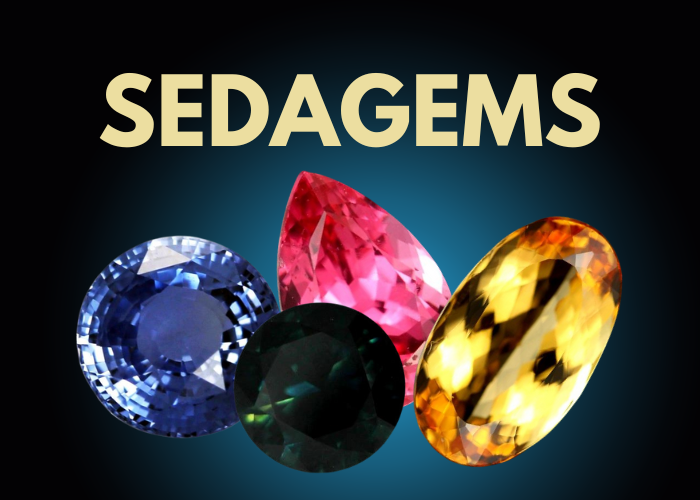Sie haben bei dieser Auktion nicht geboten.
12.45 CTS ALEXANDRITE - SPECIMEN FROM TANZANIA [S-SAFE249]
- Artikelnummer
- Abmessungen (mm)
- 10.000 x 7.000 x 6.000mm
- Gewicht (cts)
- 12.450
- Typ
- Specimen
- Farben
-
ALEXANDRITE SPECIMEN
This is a natural untreated Alexandrite specimen from Tanzania which i bought from the miner on my last trip there. They are not suitable for faceting but can be cabbed or kept as a specimen.
The most sensational feature about this stone, however, is its surprising ability to change its colour. Green or bluish-green in daylight, alexandrite turns a soft shade of red, purplish-red or raspberry red in incandescent light. This unique optical characteristic makes it one of the most valuable gemstones of all, especially in fine qualities.
Alexandrite is very scarce: this is due to its chemical composition. It is basically a chrysoberyl, a mineral consisting of colourless or yellow transparent chrysoberyl, chrysoberyl cat’s eye and colour-changing alexandrite (also in cat’s eye varieties). It differs from other chrysoberyls in that it not only contains iron and titanium, but also chromium as a major impurity. And it is this very element which accounts for the spectacular colour change. Rarely, vanadium may also play a part. According to CIBJO nomenclature, only chrysoberyls displaying a distinct change of colour may be termed alexandrite.
Like many other gemstones, alexandrite emerged millions of years ago in a metamorphic environment. But unlike many others, its formation required specific geological conditions. The chemical elements beryllium (a major constituent in chrysoberyl) and chromium (the colouring agent in alexandrite) have contrasting chemical characteristics and do not as a rule occur together, usually being found in contrasting rock types. Not only has Nature brought these contrasting rock types into contact with each other, but a lack of the chemical element silica (the second most common element in the Earth’s crust) is also required to prevent the growth of emerald. This geological scenario has occurred only rarely in the Earth’s history and, as a result, alexandrite crystals are very scarce indeed.
- Artikelnummer
- Abmessungen (mm)
- 10.000 x 7.000 x 6.000 mm
- Gewicht (cts)
- 12.450
- Typ
- Specimen
- Farben
-
ALEXANDRITE SPECIMEN
This is a natural untreated Alexandrite specimen from Tanzania which i bought from the miner on my last trip there. They are not suitable for faceting but can be cabbed or kept as a specimen.
The most sensational feature about this stone, however, is its surprising ability to change its colour. Green or bluish-green in daylight, alexandrite turns a soft shade of red, purplish-red or raspberry red in incandescent light. This unique optical characteristic makes it one of the most valuable gemstones of all, especially in fine qualities.
Alexandrite is very scarce: this is due to its chemical composition. It is basically a chrysoberyl, a mineral consisting of colourless or yellow transparent chrysoberyl, chrysoberyl cat’s eye and colour-changing alexandrite (also in cat’s eye varieties). It differs from other chrysoberyls in that it not only contains iron and titanium, but also chromium as a major impurity. And it is this very element which accounts for the spectacular colour change. Rarely, vanadium may also play a part. According to CIBJO nomenclature, only chrysoberyls displaying a distinct change of colour may be termed alexandrite.
Like many other gemstones, alexandrite emerged millions of years ago in a metamorphic environment. But unlike many others, its formation required specific geological conditions. The chemical elements beryllium (a major constituent in chrysoberyl) and chromium (the colouring agent in alexandrite) have contrasting chemical characteristics and do not as a rule occur together, usually being found in contrasting rock types. Not only has Nature brought these contrasting rock types into contact with each other, but a lack of the chemical element silica (the second most common element in the Earth’s crust) is also required to prevent the growth of emerald. This geological scenario has occurred only rarely in the Earth’s history and, as a result, alexandrite crystals are very scarce indeed.
| Versandanbieter | Versand nach Australia | Versand in den Rest der Welt |
|---|---|---|
| FedEx | $12.00 / 3 | $39.00 / 10 |
|
Australia
FedEx erhält Rabatt auf $12.00 bei Bestellungen mit 2 oder mehr Artikeln
Rest der Welt
FedEx erhält Rabatt auf $39.00 bei Bestellungen mit 2 oder mehr Artikeln
|
||
| Registered Shipping | $9.00 / 7 | $16.00 / 21 |
|
Australia
Registered Shipping erhält Rabatt auf $9.00 bei Bestellungen mit 2 oder mehr Artikeln
Rest der Welt
Registered Shipping erhält Rabatt auf $16.00 bei Bestellungen mit 2 oder mehr Artikeln
|
||

-
 Positiv
PositivVery special item, rare. Thanks an Happy New Year from Germany.
-
 Positiv
PositivBeautiful stone, perfect packaging, fast shipment, recommendable seller.
-
 Positiv
PositivIncredible stone, never seen before. Thank you from Germany. Will order again Dr. Rainer (medical doctor from Duisburg/Germany)
-
 Positiv
PositivNice stone, perfect packaging, fast shipping, recommendable.
-
 Positiv
PositivBeautiful small mini, thanks and a good and healthy 2025.
Warum überbieten sich Nutzer selbst?
Wenn ein Gebot abgegeben wird, ist dies der Höchstbetrag, den eine Person für das Produkt bieten möchte. Unser System bietet dann automatisch im Namen des Bieters und erhöht das Gebot schrittweise bis zum Höchstbetrag, um die Position des Höchstbietenden beizubehalten.
Wenn ein Symbol mit der Aufschrift „Automatisches Gebot“ angezeigt wird, bedeutet dies, dass unser System aktiv Gebote für den Bieter basierend auf seinem Höchstgebot abgibt. Dies kann so aussehen, als würden die Bieter sich selbst überbieten, aber es ist lediglich das Ergebnis der Aktualisierung des Gebots durch das System, um das Höchstlimit des Bieters widerzuspiegeln.




![44.45 CTS FIRE AGATE NATURAL SPECIMEN [MGW5613]](https://liveplatforms-production.b-cdn.net/tenants/gr/uploads/images/1135000-1139999/1137304/5e55d98bec082.jpg?width=480&aspect_ratio=1001%3A1000)
![173.20 CTS AMETHYST CHOCOLATE SPECIMEN [MGW4114]](https://liveplatforms-production.b-cdn.net/tenants/gr/uploads/images/395000-399999/398510/52cf8c692d487.JPG?width=480&aspect_ratio=1001%3A1000)
![66 CTS TOURMALINE MUSHROOM SPECIMEN BURMA [MGW2471]](https://liveplatforms-production.b-cdn.net/tenants/gr/uploads/images/305000-309999/306719/306719_1351580779.jpg?width=480&aspect_ratio=1001%3A1000)
![35.50 CTS LEPIDOLITE SPECIMEN FROM BRAZIL - [MGW2097]](https://liveplatforms-production.b-cdn.net/tenants/gr/uploads/images/280000-284999/281088/281088_1341207258.jpg?width=480&aspect_ratio=1001%3A1000)






